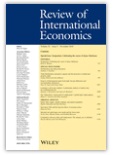Publications - Journal paper - academic journal
Publication Types:
A Discussion of Anil K. Kashyap's Paper "Sorting Out Japan's Financial Crisis"
The purpose of this article is to discuss the paper by Anil K. Kashyap on Japan’s financial crisis (Kashyap 2002). The reader is advised to read Kashyap’s paper in parallel with this discussion, which closely follows the structure of his paper. Comments on Kashyap’s statements are made in chronological order, and using Kashyap’s section headings.

Towards a New Monetary Paradigm: A Quantity Theorem of Disaggregated Credit, with Evidence from Japan
Abstract
Three important “anomalies” that have occured in the 1980s in several countries, including Scandinavia and Japan, have challenged the traditional monetary model: (1) the observed velocity decline and consequent instability of the money demand function; (2) significant asset price rises, often referred to as “bubbles” and (3) enormous capital outflows from Japan in the 1980s and a sudden reversal in the 1990s. In this paper, a simple model is proposed that encompasses traditional theory and manages to explain the three main anomalies. It centres on a “quantity theory” framework of credit-money ciruclation, which is disaggregated into “real” and financial transactions. Excess credit creation in the “financial circulation” is shown to be resopnsible for asset price booms, the observed velocity decline and, in an open economy extension, foreign investment. Empirical evidence from Japan supports the model. Implications for theory, further research and policy are explored.

Japanese Foreign Investment and the “Land Bubble”
Abstract
The aim of this paper is to examine the determinants of Japanese net long‐term capital flows in the 1980s and early 1990s. A basic framework is proposed which takes account of Japan’s so‐called land bubble by incorporating the interaction of land with the banking sector in a macroeconomic portfolio model of capital flows. Empirical evidence is supportive of the hypothesis that land‐related bank loans have been a major determinant of Japanese net long‐term foreign investment. the hypothesis of substitution between direct and indirect foreign investment also receives support, and areas of future research are mentioned.
